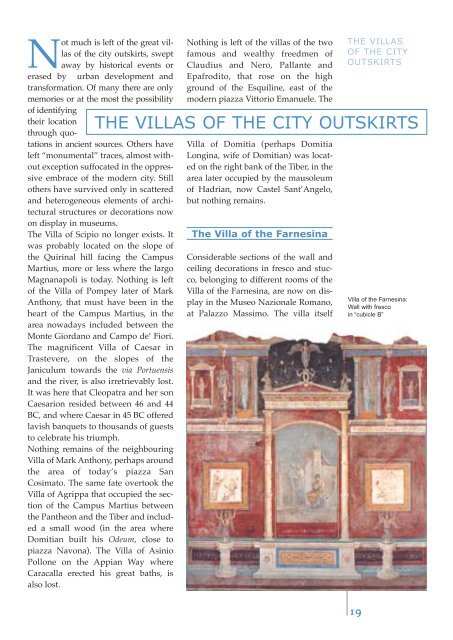You also want an ePaper? Increase the reach of your titles
YUMPU automatically turns print PDFs into web optimized ePapers that Google loves.
Not much is left <strong>of</strong> the great villas<br />
<strong>of</strong> the city outskirts, swept<br />
away by historical events or<br />
erased by urban development and<br />
transformation. Of many there are only<br />
memories or at the most the possibility<br />
<strong>of</strong> identifying<br />
their location<br />
through quotations<br />
in ancient sources. Others have<br />
left “monumental” traces, almost without<br />
exception suffocated in the oppressive<br />
embrace <strong>of</strong> the modern city. Still<br />
others have survived only in scattered<br />
and heterogeneous elements <strong>of</strong> architectural<br />
structures or decorations now<br />
on display in museums.<br />
The Villa <strong>of</strong> Scipio no longer exists. It<br />
was probably located on the slope <strong>of</strong><br />
the Quirinal hill facing the Campus<br />
Martius, more or less where the largo<br />
Magnanapoli is today. Nothing is left<br />
<strong>of</strong> the Villa <strong>of</strong> Pompey later <strong>of</strong> Mark<br />
Anthony, that must have been in the<br />
heart <strong>of</strong> the Campus Martius, in the<br />
area nowadays included between the<br />
Monte Giordano and Campo de’ Fiori.<br />
The magnificent Villa <strong>of</strong> Caesar in<br />
Trastevere, on the slopes <strong>of</strong> the<br />
Janiculum towards the via Portuensis<br />
and the river, is also irretrievably lost.<br />
It was here that Cleopatra and her son<br />
Caesarion resided between 46 and 44<br />
BC, and where Caesar in 45 BC <strong>of</strong>fered<br />
lavish banquets to thousands <strong>of</strong> guests<br />
to celebrate his triumph.<br />
Nothing remains <strong>of</strong> the neighbouring<br />
Villa <strong>of</strong> Mark Anthony, perhaps around<br />
the area <strong>of</strong> today’s piazza San<br />
Cosimato. The same fate overtook the<br />
Villa <strong>of</strong> Agrippa that occupied the section<br />
<strong>of</strong> the Campus Martius between<br />
the Pantheon and the Tiber and included<br />
a small wood (in the area where<br />
Domitian built his Odeum, close to<br />
piazza Navona). The Villa <strong>of</strong> Asinio<br />
Pollone on the Appian Way where<br />
Caracalla erected his great baths, is<br />
also lost.<br />
Nothing is left <strong>of</strong> the villas <strong>of</strong> the two<br />
famous and wealthy freedmen <strong>of</strong><br />
Claudius and Nero, Pallante and<br />
Epafrodito, that rose on the high<br />
ground <strong>of</strong> the Esquiline, east <strong>of</strong> the<br />
modern piazza Vittorio Emanuele. The<br />
Villa <strong>of</strong> Domitia (perhaps Domitia<br />
Longina, wife <strong>of</strong> Domitian) was located<br />
on the right bank <strong>of</strong> the Tiber, in the<br />
area later occupied by the mausoleum<br />
<strong>of</strong> Hadrian, now Castel Sant’Angelo,<br />
but nothing remains.<br />
The Villa <strong>of</strong> the Farnesina<br />
Considerable sections <strong>of</strong> the wall and<br />
ceiling decorations in fresco and stucco,<br />
belonging to different rooms <strong>of</strong> the<br />
Villa <strong>of</strong> the Farnesina, are now on display<br />
in the Museo Nazionale Romano,<br />
at Palazzo Massimo. The villa itself<br />
THE VILLAS<br />
OF THE CITY<br />
OUTSKIRTS<br />
THE VILLAS OF THE CITY OUTSKIRTS<br />
Villa <strong>of</strong> the Farnesina:<br />
Wall with fresco<br />
in “cubicle B”<br />
1 9

















